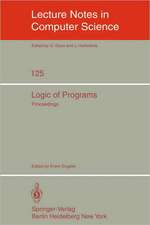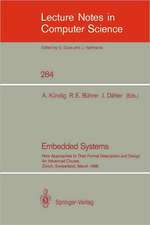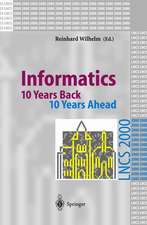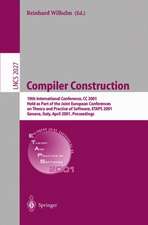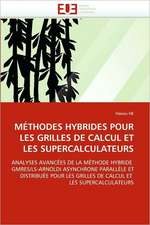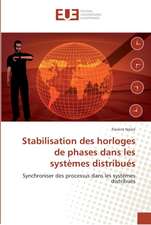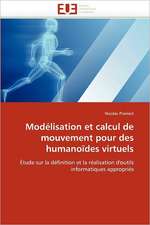Compiler Design: Syntactic and Semantic Analysis
Autor Reinhard Wilhelm, Helmut Seidl, Sebastian Hacken Limba Engleză Hardback – 28 mai 2013
This book deals with the analysis phase of translators for programming languages. It describes lexical, syntactic and semantic analysis, specification mechanisms for these tasks from the theory of formal languages, and methods for automatic generation based on the theory of automata. The authors present a conceptual translation structure, i.e., a division into a set of modules, which transform an input program into a sequence of steps in a machine program, and they then describe the interfaces between the modules. Finally, the structures of real translators are outlined. The book contains the necessary theory and advice for implementation.
This book is intended for students of computer science. The book is supported throughout with examples, exercises and program fragments.
| Toate formatele și edițiile | Preț | Express |
|---|---|---|
| Paperback (2) | 386.36 lei 6-8 săpt. | |
| Springer Berlin, Heidelberg – 24 iun 2015 | 386.36 lei 6-8 săpt. | |
| Springer Berlin, Heidelberg – 23 aug 2016 | 469.59 lei 6-8 săpt. | |
| Hardback (2) | 473.56 lei 6-8 săpt. | |
| Springer Berlin, Heidelberg – 14 aug 2012 | 473.56 lei 6-8 săpt. | |
| Springer Berlin, Heidelberg – 28 mai 2013 | 533.60 lei 6-8 săpt. |
Preț: 533.60 lei
Preț vechi: 667.00 lei
-20% Nou
Puncte Express: 800
Preț estimativ în valută:
102.12€ • 110.88$ • 85.78£
102.12€ • 110.88$ • 85.78£
Carte tipărită la comandă
Livrare economică 22 aprilie-06 mai
Preluare comenzi: 021 569.72.76
Specificații
ISBN-13: 9783642175398
ISBN-10: 3642175392
Pagini: 220
Ilustrații: X, 225 p.
Dimensiuni: 155 x 235 x 22 mm
Greutate: 0.47 kg
Ediția:2013
Editura: Springer Berlin, Heidelberg
Colecția Springer
Locul publicării:Berlin, Heidelberg, Germany
ISBN-10: 3642175392
Pagini: 220
Ilustrații: X, 225 p.
Dimensiuni: 155 x 235 x 22 mm
Greutate: 0.47 kg
Ediția:2013
Editura: Springer Berlin, Heidelberg
Colecția Springer
Locul publicării:Berlin, Heidelberg, Germany
Public țintă
Upper undergraduateCuprins
Introduction.- Lexical Analysis.- Syntactic Analysis.- Semantic Analysis.- References.- Index.
Recenzii
From the reviews:
“This is the second book in a series of textbooks on compilers, intended for students of computer science. … The level of detail and the large number of exercises make the book suitable for self-study.” (Johan Georg Granström, zbMATH, Vol. 1273, 2013)
“This is the second book in a series of textbooks on compilers, intended for students of computer science. … The level of detail and the large number of exercises make the book suitable for self-study.” (Johan Georg Granström, zbMATH, Vol. 1273, 2013)
Notă biografică
The authors are among the established experts on compiler construction, with decades of related teaching experience. Prof. Dr. Reinhard Wilhelm is the head of the Compiler Design Lab of the Universität des Saarlandes, and his main research interests include compiler construction; Prof. Dr. Helmut Seidl heads the Institut für Informatik of the Technische Universität München, and his main research interests include automatic program analysis and the design and implementation of programming languages; Dr. Sebastian Hack is a Junior Professor in the Computer Science Programming Group of the Universität des Saarlandes, and his main research areas include compilers and code generation.
Textul de pe ultima copertă
While compilers for high-level programming languages are large complex software systems, they have particular characteristics that differentiate them from other software systems. Their functionality is almost completely well-defined – ideally there exist complete precise descriptions of the source and target languages. Additional descriptions of the interfaces to the operating system, programming system and programming environment, and to other compilers and libraries are often available.
This book deals with the analysis phase of translators for programming languages. It describes lexical, syntactic and semantic analysis, specification mechanisms for these tasks from the theory of formal languages, and methods for automatic generation based on the theory of automata. The authors present a conceptual translation structure, i.e., a division into a set of modules, which transform an input program into a sequence of steps in a machine program, and they then describe the interfaces between the modules. Finally, the structures of real translators are outlined. The book contains the necessary theory and advice for implementation.
This book is intended for students of computer science. The book is supported throughout with examples, exercises and program fragments.
This book deals with the analysis phase of translators for programming languages. It describes lexical, syntactic and semantic analysis, specification mechanisms for these tasks from the theory of formal languages, and methods for automatic generation based on the theory of automata. The authors present a conceptual translation structure, i.e., a division into a set of modules, which transform an input program into a sequence of steps in a machine program, and they then describe the interfaces between the modules. Finally, the structures of real translators are outlined. The book contains the necessary theory and advice for implementation.
This book is intended for students of computer science. The book is supported throughout with examples, exercises and program fragments.
Caracteristici
Written by established experts Illustrated with many examples, exercises and program fragments Second book in a 4-volume set Includes supplementary material: sn.pub/extras





